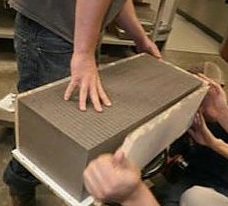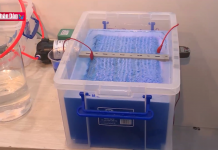Geopolymer, also known as, natural composite concrete is the newest eco-friendly building material. The prefix “Geo”, says that in its production only natural ingredients are used. In 1978, Joseph Davidovec introduced the concept of geopolymer at Louisiana University of Technology, and a few decades later, a group of scientists led by Professor Erez Elloche developed and researched the composition of this innovative concrete mix.

Composition and properties
The composition of geopolymer concrete includes only natural components, such as liquid glass, fly ash, slag and other components used for bonding and fixing mixtures. It is made by mixing these ingredients in well-defined proportions, at very low temperatures. Due to the chemical processes that occur in such a mixture, creating monolithic stone, whose properties are many times superior to ordinary Portland cement.
According to research, geopolymer is very resistant to corrosion, and also emits various gases that contribute to the “greenhouse effect” 90% less than standard concrete. Lab tests also show the material to be highly fire resistant – able to withstand up to 1316°C, as well as having tensile and compressive strengths.
In addition, it is very resistant to the effects of various corrosive environments, including the effects of acids. Unlike conventional concrete, for example, for sculptures, geopolymer has a very low permeability, comparable to that of natural granite, and much less shrinkage.
In addition to low permeability and high strength, excellent resistance to the effects of temperature and acids, low shrinkage, the geopolymer is capable of fast setting and resistant to repeated thaw-freeze cycles. In addition, unlike conventional concrete, it has a significantly lower mass.
Scientists in different countries continue to improve and perfect the properties so that it can be used in both civil engineering and transportation. Geopolymer production developed in Russia. When combining environmentally friendly concrete and wood, the material is quite cheap.
For production, chopped wood is used, which is then soaked in water and treated with an ozonizer. After the same treatment, the resulting wood mass is fed into the concrete mixer and combined with the binder components of the mixture. After mixing, the mixture is poured into the space between the formwork, and the formwork itself is also the electrodes.
Its dimensions are meters by meters. From an autonomous power source through a transducer, for one hour the mixture is subjected to an electric current through the formwork-electrodes. After hardening the treated piece, the formwork is removed and further folded.
After knowing the unique properties, many of the self-taught builders try to find information on how to make geopolymer concrete with their own hands and from readily available materials. Indeed this is possible. The fact is that a good knowledge of the physical and chemical properties and characteristics of the components, as well as the ability to experiment, is required, since there is no exact formula and proportions of the components that make up geopolymer concrete.
Strictly speaking, scientists and manufacturers have the recipe, but no one is in a hurry to share it and the technology of producing synthetic concrete with others. This means that good results can be obtained only by a “trial and error” method.

If you still want to experiment, then keep in mind that adhesive components often use water-soluble resins or PVA, an exceptional consistency. The polyvinyl alcohol contained in this PVA acts as an emulsifier for the mixture.
For the concrete mix you create to be of high quality, the polymer or any other organic admixture should make up about 20% of the total cement mass. The best quality mass is obtained by introducing a water-soluble polyamide or epoxy resin composition, followed by the addition of a polyethylene-polyamine hardener.
Geopolymer concrete solutions are prepared in the same way as standard cement mixes. Water is poured into the concrete mixer with a small amount of special cement used for polymer concrete. After cementing, fly ash and slag are added to the mixture in equal proportions. Everything is thoroughly mixed, then the polymer ingredients are added, and the whole mixture is stirred until ready.
Geopolymer concrete
Concrete mixtures, obtained by forming and hardening components of natural origin, are called composite or geopolymer concrete. Geopolymer concrete in ancient times was used to erect objects (Egyptian pyramids, ancient St. Petersburg sculptures, dolmens and many others) that have survived to this day.
Special features of geopolymer concrete:
- reliability;
- high-tech characteristics;
- small density;
- not corroded;
- does not form cracks on the surface;
- low thermal conductivity;
- high density granite thread;
- materials with refractory properties;
- elasticity;
- compressive strength and tensile strength;
- the material is not susceptible to the effects of chemicals;
- easily withstand temperature changes;
- good price.














